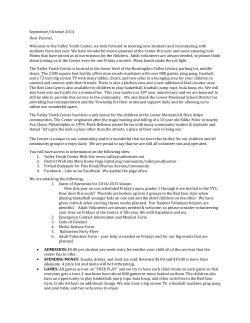
GEOLOGY OF CORRIDOR H
GEOLOGY OF CORRIDOR H Geological Society of Washington Fall field trip, 2014 Leaders: Callan Bentley (NOVA), Dan Doctor (USGS), Alan Pitts (Univ. of Camerino) Geologic provinces of the Mid-Atlantic region A closer look reveals that one of the physiographic provinces has two distinct parts, each telling a very different part of the story: the Piedmont province is subdivided into the “metamorphic Piedmont” (crystalline rocks of the Appalachian mountain belt) and the “Triassic rift basins” (Mesozoic lowlands). By making this distinction, we can move from physiography to geologic meaning. So from this point forward, we will refer to the geologic provinces of the midAtlantic region (Virginia, Maryland, West Virginia, Delaware, and Washington, DC). The overall list of geologic provinces, running from east to west at the latitude of Washington, DC, is therefore: (1) the Coastal Plain, (2) the Piedmont, (3) the Culpeper Basin, (4) the Blue Ridge, (5) the Valley & Ridge, and (6) the Alleghany Plateau (also more broadly called the Appalachian Plateaus). The boundary between the Coastal Plain and the Piedmont is known as the “Fall Line” or the “Fall Zone,” as that’s the area where waterfalls and rocky rapids appear in the rivers that flow east to the Atlantic. All the major cities of the east coast are built along this important feature: Washington, DC is merely the most prominent, but a fuller list would include Philadelphia, Baltimore, Fredericksburg, Richmond, and Raleigh/Durham. While “east to west” organizes the geologic provinces in space, it does not organize them in time. It is perhaps better to think about the provinces in terms of the chronological order of their formation. In that case, we would go from oldest to youngest: (1) Blue Ridge, (2) Piedmont + (3) Valley & Ridge [contemporaneous], (4) Alleghany Plateau, (5) Culpeper Basin, and (6) Coastal Plain. The map on the next pages shows how they relate to one another. 2 Map by Chuck Bailey, 1999 Our region of the country is divided into 5 physiographic provinces (areas of the land that have a common appearance or landscape). This topography is determined almost entirely by the underlying rock units, which are where they are due to the course of the region’s geologic history. You can think of the different physiographic provinces as each representing a “chapter” in the “book” that describes the region’s overall geologic history. It’s a long story that spans more than a billion years of time and tectonics. 3 Though this map is centered on Virginia, it also includes relevant locations that we will visit in adjacent states and DC. Overview: Map by Ron Schott, 2014 The rocks of the Mid-Atlantic region (Virginia, Maryland, Delaware, Washington, DC, and West Virginia) record two complete “Wilson cycles” of supercontinent assembly and break-up, interspersed with periods of passive margin sedimentation and tectonic calm. The story begins in the Mesoproterozoic era, about 1.1 billion years ago (Ga), with the accretion of the Grenville terrane to the ancestral North American continent. This collision of an independent chunk of continental crust with the larger ancestral North American continent (also called “Laurentia”) was only the most recent event in a chain of terrane collisions that had been playing out since Archean times. A map of North America’s craton (the more or less stable Precambrian ‘nucleus’ of the continent) shows how these terranes have accumulated over time: 4 Rodinia lasted for a while, and the Grenvillian Mountains were subject to weathering and erosion, ultimately exposing the high-grade metamorphic rocks (gneisses) and plutonic igneous rocks (granites and granitoids) at the roots of those ancient mountains. Deposited on top of these exposed mountain roots were clastic sediments (mud, sand, gravel) that later lithified to become shale, arkosic sandstone, and conglomerate. Then Rodinia began to break up. An initial episode of extension occurred around 730 million years ago (Ma), and a final episode of extension (rifting) occurred around 565 Ma, accompanied by vast eruptions of mafic lava (basalt). Rodinia broke apart, and between its separating fragments, a new ocean basin formed. North America moved off in one direction, and the Congo craton and Amazonia craton moved off in the opposite direction. Seafloor spreading filled the gap between them, and the Iapetus Ocean was “born.” 550 Ma At this time, ancestral North Ancestral America was south of the Europe equator, and the future MidAtlantic region of the Iapetus Ocean continent faced southwest rather than southeast, as in Ancestral the modern day. The paleoNorth geographic map by Ron America Blakey for 550 Ma shows this well. Iapetus Ocean As the Iapetus Ocean widened, oceanic crust grew off the rifted edge of Amazonia / Congo 5 cratons Map by Ron Blakey, 2006 Note that western Virginia originated at the time of the docking of the Grenvillian micro-continent with proto-North-America. The Grenville Orogeny was an episode of mountain-building that resulted from this collision. All around the world, between 1.2 and 1.0 Ga, continents and micro-continents were colliding with one another, assembling a supercontinent called Rodinia. ancestral North America. The “eastern” margin of what is today the Mid-Atlantic region got further and further from the edge of the tectonic plate. It switched from being an active continental margin (convergent @ 1.1 Ga; divergent @ 730565 Ma) to a passive continental margin. The cooling crust contracted (making it denser) and subsided. This allowed the accumulation of passive margin sediments (mature sedimentary rocks) atop the older crust. A worldwide rise in sea level caused marine waters to transgress across the North American continent during the Cambrian period of geologic time, flooding the continental crust to make an epeiric sea called the Sauk Sea. 500 Ma Ancestral North America Iapetus Ocean 6 Map by Ron Blakey, 2006 Sauk Sea Meanwhile, the Iapetus Ocean had begun to contract. A subduction zone formed, initiating a growing chain of volcanic islands. As subduction consumed the oceanic crust on the fringe of the North American plate, the volcanic island arc got closer and closer to the future Mid-Atlantic region. This volcanic archipelago collided with the edge of the ancestral North American continent occurred around 460 Ma (late Ordovician time). This collision, the Taconian Orogeny (also called the “Taconic” Orogeny) built a range of mountains. These mountains’ roots are marked in the Piedmont by typical signatures of orogeny: partial melting, deformation, and metamorphism. Sediments eroded off the top of the mountains were carried downhill by rivers and turbidity currents, and deposited with volcanic ash in immature layers (e.g. graywacke) in the epeiric sea to the “west” (in modern terms). This is the future Valley & Ridge province. After the Taconian Orogeny, the future Mid-Atlantic region reverted to more passive margin sedimentation, marked by the accumulation of more mature sediments such as quartz sand and limy mud. Offshore, in the Iapetus Ocean, a new subduction zone formed, and brought a small microcontinent closer and closer to North America. This microcontinent, dubbed Avalonia, collided with ancestral North America around 360 Ma (Devonian period) in the Acadian Orogeny. Much of eastern New England and the maritime provinces of Canada were accreted to the continent at this time. In the Mid-Atlantic region, vast quantities of sediments from this second phase of Appalachian mountain-building poured into the epeiric seas, filling them to the brim with clastic sediment, and aggrading rivers (and floodplains) further and further to the west. Again, these piled up in a nice stack to the west of the mountains, in the region that would later become the Valley & Ridge. The ultimate paroxysm of Appalachian mountain-building came with the final closure of the Iapetus Ocean, when the continent on the other side, ancestral Africa (the leading edge of Gondwana) collided with ancestral North America. This continent-continent collision is known as the Alleghanian Orogeny. It began around 300 Ma, and was pretty much over by 250 Ma (Pennsylvanian-Permian). As the Iapetus Ocean “died,” a new supercontinent was born: Pangaea. 7 Running through the middle of Pangaea was a Himalayan-size mountain chain: the young Appalachians, finally complete. During this time, older rocks of the Blue Ridge were metamorphosed, and the sedimentary strata of the Valley & Ridge were folded into anticlines and synclines, as well as being thrust-faulted to the northwest. The resulting fold and thrust belt is well exposed on Corridor H. 290 Ma Ancestral Europe Ancestral North America Mountain Belt Ancestral Africa Young Appalachian Ancestral South America Pangaea was the largest supercontinent the world has ever known. Over geologic time, partial melting of older rocks yields more felsic magma, which cools and crystallizes to make granite, the stuff that continental crust is mostly made from. 8 Map by Ron Blakey, 2006 PANGAEA The total proportion of continental crust on Earth has increased over time, with Pangaea being the largest accumulation of that crust … so far! Ultimately, Pangaea lasted for tens of millions of years, through the greatest extinction event in Earth history, and into the early Mesozoic era. In the Triassic, continental extension (rifting) had once again resumed, resulting in a series of rift valleys that opened up amid the mountainous terrain. These basins filled with immature clastic sediments and mafic lava, and eventually some of them connected up to form a gradually-widening narrow ocean basin. The Atlantic Ocean was born, and Pangaea “died” as its continental fragments drifted apart. It was not a clean break: parts of what used to be “North America” stuck to Europe (e.g., northern Scotland), and parts of what used to be “Africa” stuck to North America (e.g., Florida). The Appalachian Mountains were gradually worn down by weathering and erosion, and by the Cretaceous, the mountains had been exposed to their deep roots. Rivers stopped cutting down, and began depositing new layers of sediment. As time went by, particularly during the Miocene, thick accumulations of clastic sediment and carbonate material accumulated on the new passive margin. These are the layers of the Coastal Plain. During the Pleistocene epoch of the Quaternary period, global cooling (probably initiated by the closure of the Isthmus of Panama and the ensuing diversion of the Gulf Stream into the North Atlantic) caused the buildup of massive ice sheets atop northern Europe, Siberia, and North America. These glaciers existed because of removal of huge amounts of water from the world ocean, causing sea level to drop by around 100 meters (~330 feet). The rivers which were until then depositing sediment switched into erosional mode instead, cutting down (incising) into the landscape and initiating the “falls” along the Fall Line. 9 1.2-1.0 Ga Grenville Orogeny (assembly of Rodinia) 730-565 Ma Breakup (rifting) of Rodinia; opening of Iapetus Ocean 550-470 Ma Passive margin sedimentation; transgression 460 Ma Taconian Orogeny (collision w/ volcanic island arc) 360 Ma Acadian Orogeny (collision w/ Avalonia microcontinent) 300-250 Ma Alleghanian Orogeny (collision w/ Africa; assembly of Pangaea) 200-180 Ma Pangaea breaks up; Culpeper Basin rifting; Atlantic Ocean opens 180-100 Ma Erosion of ancestral Appalachian Mountains 100 Ma Deposition resumes; Coastal Plain strata begin to be deposited 35 Ma Impact of Chesapeake Bay bolide 2 Ma Pleistocene “ice ages” begin; lower sea level; Potomac incision 0.00000 Ma GSW field trip to Corridor H happens for the 1st time Washington Post, 1998, courtesy of Bill Burton Wilson Cycle #1 Wilson Cycle #2 In summary, the timeline of key events for the Mid-Atlantic region is: 10 Marshak, 2009 Overview of east coast tectonics over the past 1.2 billion years 11 Valley & Ridge: The Valley and Ridge province is the fold-and-thrust belt of the Alleghanian Orogen. While the core of this late Paleozoic mountain belt was to the east (in the Piedmont, with the displaced sliver of basement rock, the Blue Ridge province, in between, the flanks of the young Appalachian mountains were in this zone of “thin skinned tectonics.” That is to say, the rocks you see today in the Valley and Ridge were deposited during the early and middle Paleozoic, and were then intensely deformed (folded, faulted, and cleaved) during the late Paleozoic Alleghanian Orogeny. Thus, the rocks of the Valley and Ridge province tell three distinct stories: (1) a sedimentary story, about changing depositional conditions over time, (2) a deformational story about what happened to those older layers when Africa smashed into North America, and (3) a story of differential erosion, which takes all those crumpled up strata and expresses them on the Earth’s surface as valleys and ridges. There is also a part (4), unrelated to the rest: weird igneous intrusions in the Eocene. That won’t be covered on this trip. The depositional history of the Valley and Ridge province: The sedimentary record of the Valley and Ridge stretches from the Cambrian to the Pennsylvanian period. Dozens of different formations (almost 50 in our area!) have been named and described, and a place assigned to them in the stratigraphic sequence for the area (see stratigraphic column by Lynn Fichter, next page). The names and character of the formations vary not only temporally (i.e., in the one direction of time), but also laterally, both across strike of the Appalachian Mountains (i.e., east to west) and also along strike of the Appalachian Mountains (i.e., north to south). In southwestern Virginia, Permian evaporite deposits may be found, for example, but both the Permian and the evaporites are missing in northern Virginia, Maryland, and northern West Virginia. Sedimentologists can read a great deal of information from these rocks. The conditions under which they accumulated changed dramatically over time, shifting from shallow Bahamas-like conditions (carbonate sedimentation in a tropical climate) to a deep ocean basin smothered by turbidity currents, to a pristine white sandy beach, to rivers meandering across an ancient floodplain. 12 Lynn Fichter , JMU, 1991 (reformatted 1996) 13 C.Bentley diagram The conditions changed so frequently over the 250 million years over which sediments accumulated here that you would be forgiven if it looked at first glance like a hopeless mishmash of ever-shifting conditions. However, upon applying a regional perspective to the sequence, a pattern emerges (see figure below). 14 The strata of the Valley and Ridge can be said to represent just four main sedimentary themes: (1) passive margin sedimentation in the aftermath of Rodinia’s breakup, (2) the “dirty” clastic influence of Taconian mountain-building, (3) a return to passive margin sedimentation in the ‘tectonic calm’ between the first and second pulses of Appalachian mountain-building, and finally, (4) a return to active margin sedimentation (things get “dirty” again) during the Acadian Orogeny. C.Bentley photo (EPCC pen for scale) Therefore, telling the story in chronological sequence would begin in the Cambrian period of geologic time, after the Chilhowee Group (Blue Ridge) recorded the Sauk transgression. While the majority of the North American continent was flooded by this epeiric sea, the shoreline was in the middle of the continent. Our region lay far, far from the clastic influence of the land. With no sand and no mud to deposit, the only available sediment was the dissolved ions in the ocean. Under warm, tropical conditions, limestone was deposited as calcite precipitated from seawater. Ooids formed where the waves were able to reach down and roll these little precipitated nuggets back and forth, giving them a nice even coating of calcite. Here’s an example: 15 Shallow water features in the Conococheague Formation (Cambrian limestone/dolostone): stromatolites (left); rip-up clast conglomerate (right). At the famous Tumbling Run outcrop south of Strasburg, we can observe today how the depositional setting changed under the increasingly clastic influence of the late-Ordovician Taconian Orogeny. Here, we transition from the intertidal to subtidal sedimentary facies of the New Market limestone into the reefal mound facies of the lower Lincolnshire formation, marked by much thinner bedding and the presence of fossils. The middle Lincolnshire shows darker color and pyrite, indicating deepening water conditions (and accompanying anoxia). It also features distinctive black nodules of flint (derived from siliceous sponge spicules, perhaps?). In the upper Lincolnshire, shale comes into increasing dominance, and then bentonite (devitrified volcanic ash) appears. This marks the transition to the overlying Edinburg Formation, which has a strong mud component and carbonate turbidites, interpreted as a basin-edge environment (deeper water). It crops out with a distinctive “cobbly” weathering pattern. To sum up these changes, please see the summary diagram showing both (a) features of the Tumbling Run outcrop and (b) paleo-depositional interpretations by Fichter and Diecchio (1986), next page. 16 C.Bentley photos (both) Stromatolites (fossil microbial mats that “dome” upward toward the paleo-sun) grew in profusion. Periodic tropical storms (cyclones/hurricanes) temporarily increased the water energy, resulting in carbonate-rip-up clast conglomerates and hummocky cross-stratification. The tectonic interpretation for this “muddying of the waters” was the collision of ancestral North America with a volcanic island arc. Subduction was closing the Iapetus Ocean at this time (See paleogeographic map on page 43), and eventually it brought a small volcanic archipelago into collision with the continent. This orogeny, the Taconian Orogeny, named for the modern-day Taconic Mountains of upstate New York (where it was first studied systematically), was the first of the three pulses of Appalachian mountain building that (a) closed the Iapetus Ocean and (b) helped to assemble Pangaea. While we can -observe the “roots” of the Taconian Mountains on the Billy Goat Trail near Great Falls, in the Valley & Ridge we get a different perspective on the same event: the sedimentary perspective of the basin adjacent to the rising mountain range. Overlying the Edinburg Formation is the Oranda Formation, a shale with a stillsignificant limy component, and overlying that is the voluminous Martinsburg Formation, a shale and graywacke package 3200 feet thick that is interpreted as deep marine turbidites. At first, the Martinsburg records distal submarine fan 17 Fichter and Diecchio, 1986 The bentonites weather out in negative relief: if you reach into one of those recessive overhangs, you will pull out a sticky, pulpy yellow mess. This is what 470 million year old volcanic ash looks like, long after the glass in the ash has reacted to produce clay minerals. The bentonites of the Edinburg include the Millbrig bed, a bentonite layer that has been correlated with a European bentonite of about the same age. This European ash layer goes by the name “The Big Bentonite,” and the correlated total unit has been interpreted by some workers as representing the pyroclastic fallout of the largest volcanic eruption during the entire Phanerozoic eon! However, recent geochemical fingerprinting of trace elements (Mn, Mg, and Fe) in the benonites, show two distinct element populations, which suggests that though they are near twins, they are in fact two separate events which distinct feeder magma bodies. deposits (far away from the source of the sediments), but as you work your way up higher in the sequence, you will find coarser and coarser material, implying that (a) the basin is filling up and/or (b) the mountains that supply the sediment are getting bigger/closer. The Martinsburg strata are moderately calcareous in the lower part of the formation, but they are entirely clastic (sand and mud) in the upper part. The transition from passive margin sedimentation to active margin sedimentation is complete! While mountains were being raised above Washington, DC, Interstate 81 was at the bottom of a deep marine basin, with turbidity current after turbidity current pouring in from the east. Graded bedding and planar (high-velocity) laminations in a graywacke turbidite of the late Ordovician-aged Martinsburg Formation, South Page Valley Road. coarse Eventually, this marine basin was filled with what Alpine geologists dubbed “flysch” (i.e., the turbidites of the Martinsburg Formation) and it was topped off with river and floodplain deposits - so-called “molasse.” The Taconian molasse is known as the Juniata Formation, a distinct package of redbeds. (It looks virtually identical to the Hampshire Formation redbeds, so prominent on Corridor H.) 18 C.Bentley photo fine Quartz sandstone and quartz pebble conglomerate of the Silurian-aged Massanutten (Tuscarora) Sandstone. This unit suggests a return to passive margin deposition. This clean, mature quartz sandstone signals that the Taconian Orogeny had ended by the time of its deposition (Silurian). A new subduction zone had formed, but it was still a long way out in the Iapetus Ocean, far away from disturbing the local peace. As the sediment supply dwindled, the deposition shifted back to carbonates again; the Tonoloway Formation and the Helderberg Group of limestones and dolostones came next. These are relatively thin in the east, but thicken to the west. In some of the formations, distinctive indications of shallowwater conditions may be found, including stromatolites, mudcracks, and halite casts. 19 C.Bentley photo The next unit in the sequence is a 2000’ thick formation of quartz sand, with smaller amounts of quartz pebbles and shale. This is the Massanutten Sandstone in the Shenandoah Valley. Somewhat ridiculously, it’s known as the Tuscarora Formation in every other mountain range to the west of the Great Valley. 20 Salt casts in Tonoloway dolostone, Corridor H, West Virginia C. Bentley photo Overlying this Silurian to Devonian passive-margin sequence is another clastic sequence, part of the “Catskill clastic wedge,” a thick sequence of sand, mud, gravel, and other sedimentary debris that came off another mountain range that was raised to the east. This time the mountain-building was due to the Acadian Orogeny, an episode triggered by ancestral North America’s collision with a microcontinent called Avalonia. To judge by the sheer amount of sediment it produced, the Acadian Orogeny was a much bigger event than the earlier episode of mountain-building, the Taconian Orogeny. It shows a similar signature: deepening of the sedimentary basin adjacent to the mountain belt, turbidity currents (flysch), redbeds (molasse), and plenty of sandstone, conglomerate, silt, and clay. Alan Pitts photo Mudcracks in tidal carbonates of the Silurian Tonoloway Formation, Baker Quarry, old route 55, West Virginia. The structural geology of the Valley and Ridge province: The Valley & Ridge province is not merely a stack of Paleozoic sedimentary layers, however. These strata were intensely deformed during the final (and biggest) phase of Appalachian mountain-building, the late Paleozoic Alleghanian Orogeny. This massive continent-to-continent collision between Africa and North America (see paleogeographic map on page 13) started in the Pennsylvanian period and lasted well into the Permian, from roughly 300 to roughly 250 million years ago. This collision had multiple effects: it generated huge thrust faults in the Piedmont, snapped off the Blue Ridge and thrust it westward (metamorphosing it, too), and folded, faulted, and cleaved the strata of the Valley & Ridge. These folds occur on the regional scale (e.g., the Massanutten Synclinorium), which is so large that you can’t ever see the whole fold, but it can be mapped out through carefully tracking the orientation (strike and dip) of rock layers exposed in isolated outcrops, such as these dipping layers of Massanutten Sandstone exposed above Red Hole on Passage Creek. 21 C.Bentley photo C. Bentley photo Flute casts on the bottom of a turbidite layer, Brallier Formation (Devonian), Corridor H, WVA. The rocks along Corridor H demonstrate folding and faulting on a more moderate scale: the “meso-” scale of outcrops. We will spend the day examining these strata and the structures which improved them. Sideling Hill, Maryland, is a famous syncline: another example of the profound deformation that Africa’s impact imparted to the sedimentary layers of the Valley and Ridge. However, even good old Sideling Hill is starting to show its age, growing plants in profusion and falling apart. What Sideling Hill looked like 20 years ago, Corridor H’s numerous outcrops look like today. 22 C.Bentley photo C.Bentley photo Anticline / syncline pair in Tonoloway limestone, roadcut along Corridor H, West Virginia. C.Bentley photo Bedding / cleavage relationships in upper Edinburg Formation limestone and shale/slate along Route 340, north of Front Royal. Bedding dips moderately to the right (southweast)) while sleavage is subvertical. Note the cleavage deflection through layers with different proportions of clay. 23 A few words about differential weathering: In the humid temperate climate of the mid-Atlantic region, shale and limestone weather rapidly, producing valleys, while quartz-rich sandstone and conglomerate weather more slowly, producing ridges. The simple facts of quartz’s (a) hardness and (b) chemical equilibrium explain most of the topographic variation that we see today in the Valley & Ridge. Almost every ridge is held up by quartz-rich rock, while almost every valley is underlain by limestone or shale. C.Bentley diagram The outcrop pattern determined by this deformation is the primary control on modern landscape in the Valley & Ridge province. For instance, the tough sandstone of the Massanutten Formation weathers out as the distinctive ‘fence’like ridges of the Massanutten Mountain system: 24 It’s also worth noting that extensive karst topography has developed in the carbonate strata of the Valley & Ridge, both the Cambrian-to-mid-Ordovician section and the late Silurian-to-Devonian section. Many of these caves are “wild” while others have been developed as commercial destinations, such as Luray Caverns. Natural Bridge is an example of what was once commercial, now destined to be a new state park. Examples of Shenandoah Valley karst: (Left) Natural Bridge, Virginia, a natural bridge. (Right) Luray Caverns, with Callan’s family for scale. 25 Alleghany Plateau: The Alleghany Plateau is west of the Valley & Ridge province. Essentially, it preserves slightly younger sedimentary strata (of Mississippian and Pennsylvanian age) in a less-deformed state than the Valley & Ridge’s fold and thrust belt. We will visit the very easternmost edge of the Alleghany Plateau, at the western terminus of Corridor H. You’ll know it when you see it because the entire escarpment is lined with massive white three-bladed wind turbines. The Alleghany Plateau (as well as the other Appalachian Plateaux) is just a lessdeformed version of the Valley & Ridge. Its strata are not as folded or faulted, and therefore were never uplifted to the extent of the Valley & Ridge. The uppermost layers are subsequently younger in age. Coal is an important sedimentary rock that formed at this time (the “Carboniferous”), and mountaintop-removal coal mining is practiced just west of our westernmost field trip stop. This coal is the compressed remains of ancient terrestrial plants, preserved in swampy “bayou” environments along the ancient shoreline. A quick search on the area will reveal many plant fossils. 26 C.Bentley photo Pennsylvanian-aged coal of the Alleghany Formation (overlain by sandstone), Corridor H, West Virginia. C.Bentley photos (both) Plant fossils in the Alleghany Formation, Corridor H, West Virginia. In places, possible mass transport deposits can be observed (submarine landslides), and marine deposits interfingering with terrestrial ones. These features are all consistent with the relatively rapid small-scale sea level changes that characterize the Carboniferous. These “cyclothems” were triggered by glaciation switching on and off in southern Gondwana, and resulted in the repeated drowning and burial of low-lying swamp vegetation along the coast. These ancient climate changes are the proximal reason such a wealth of coal formed around the world during the Pennsylvanian, an energy source that would drive the Industrial Revolution hundreds of millions of years later. 27 28
© Copyright 2025









